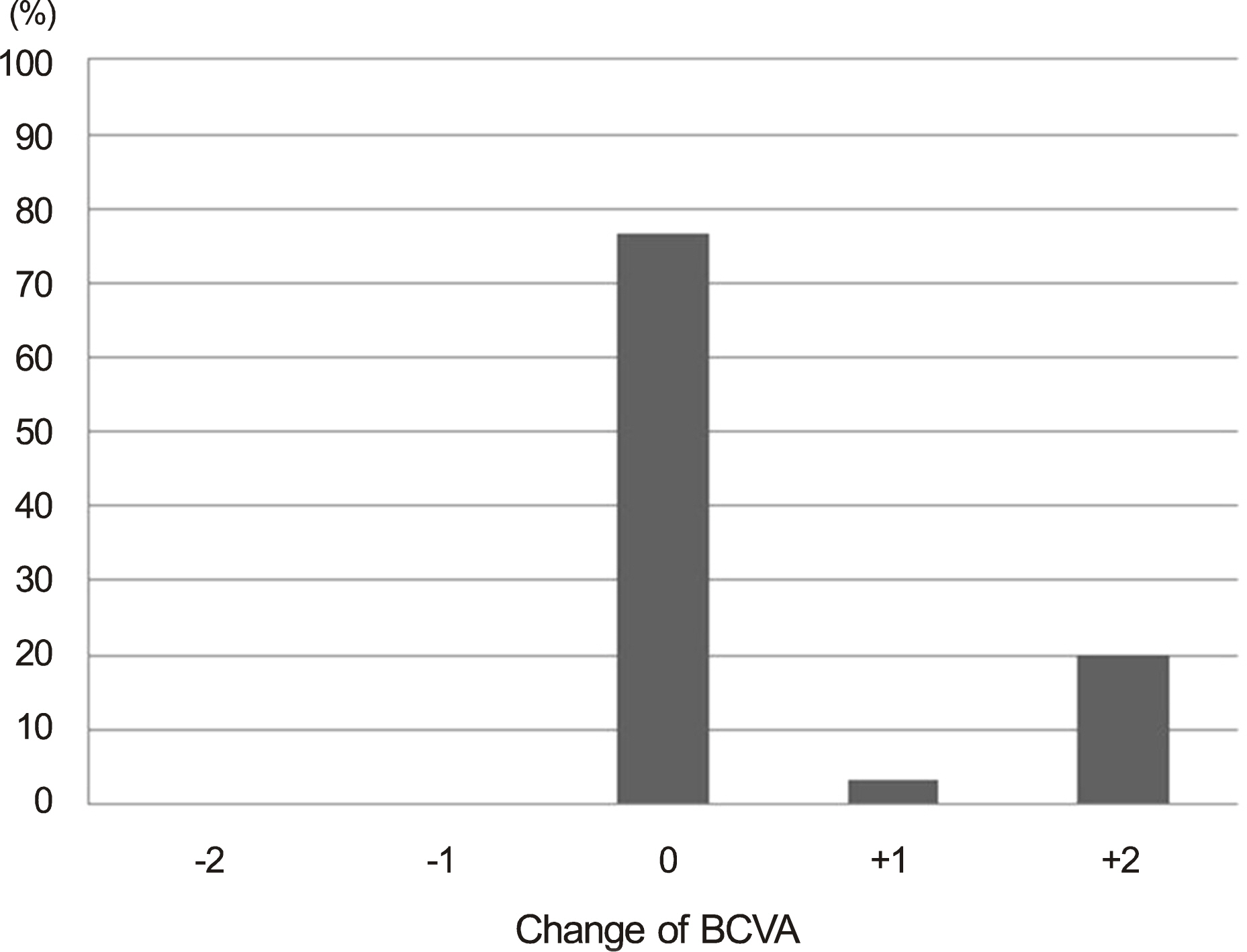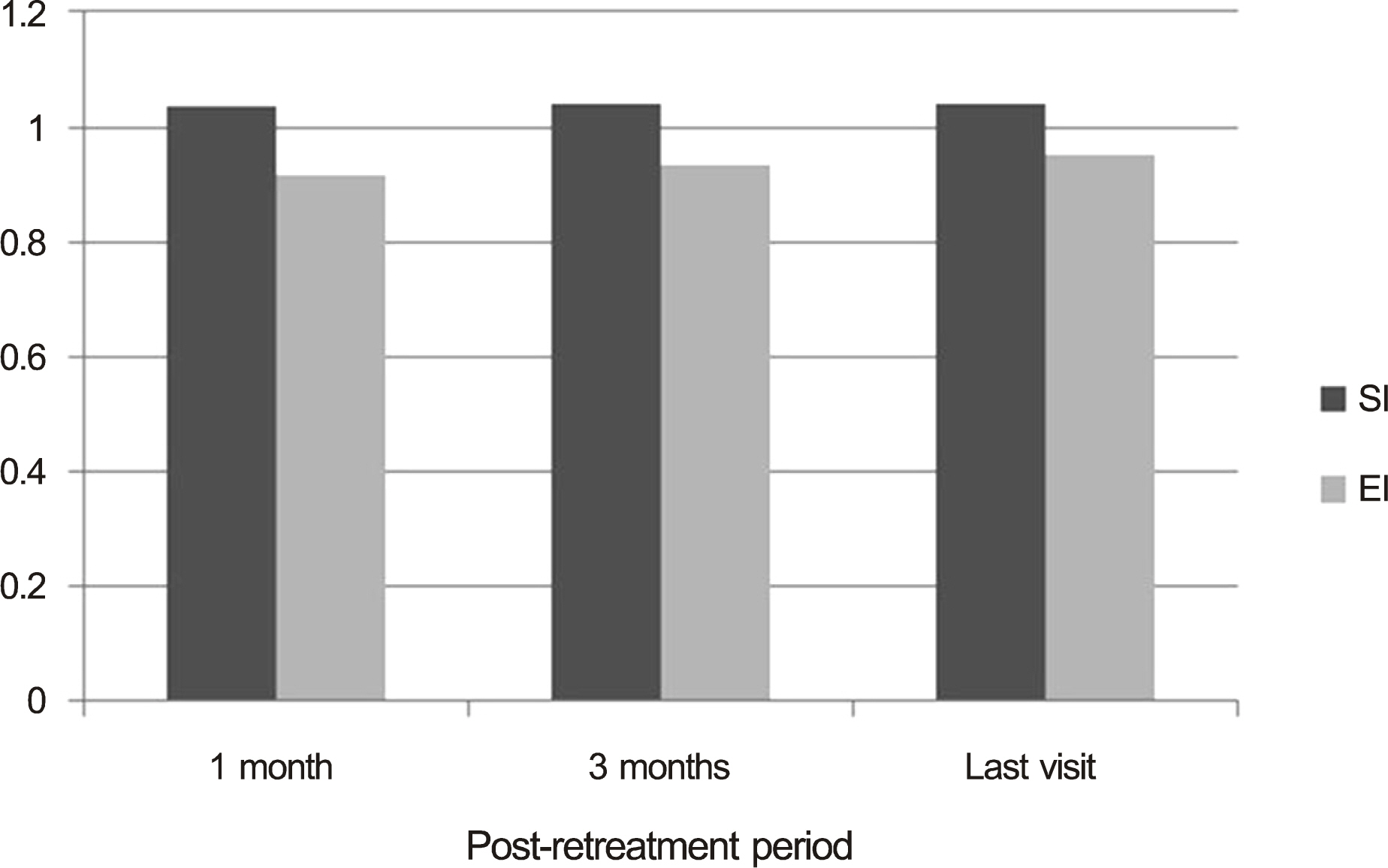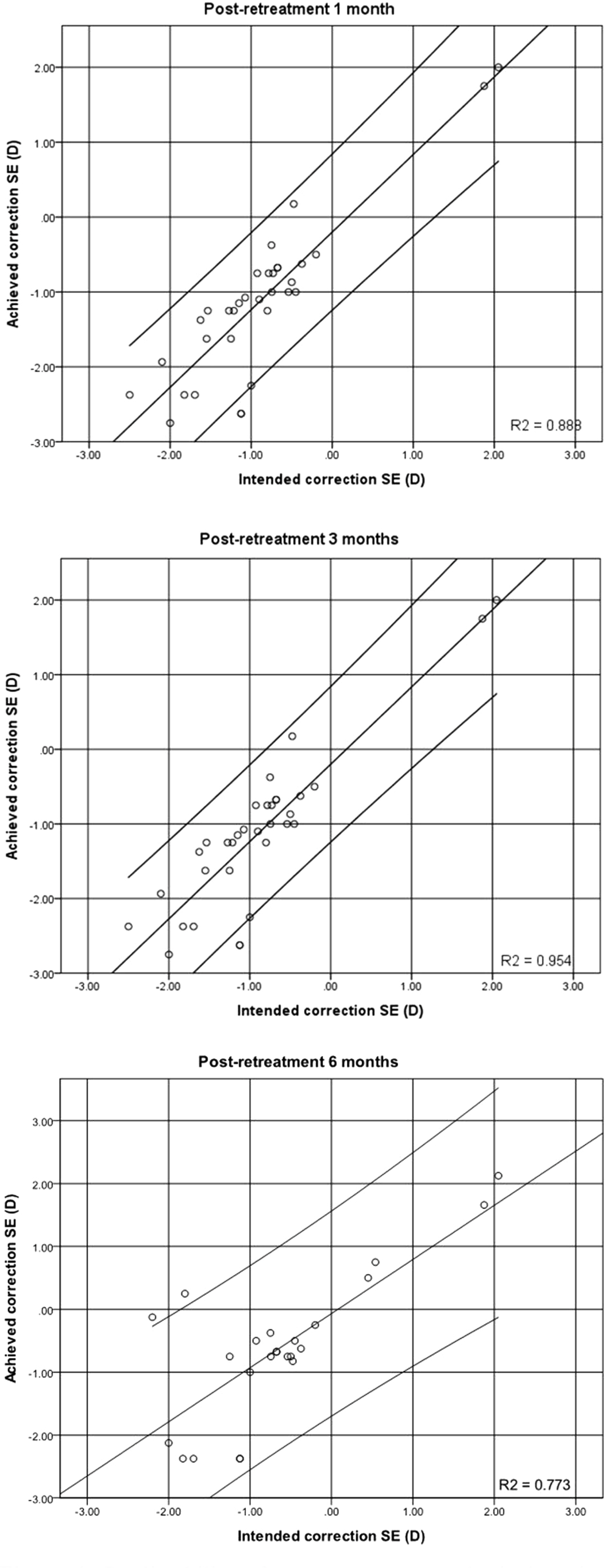J Korean Ophthalmol Soc.
2015 Feb;56(2):180-189. 10.3341/jkos.2015.56.2.180.
Clinical Outcome of Retreatment after Refractive Surgery
- Affiliations
-
- 1Department of Ophthalmology, Samsung Medical Center, Seoul, Korea. eschung@skku.edu
- KMID: 2216000
- DOI: http://doi.org/10.3341/jkos.2015.56.2.180
Abstract
- PURPOSE
To evaluate the clinical outcome of retreatment after refractive surgery.
METHODS
Retrospective analysis of 38 eyes of 24 patients who received retreatment surgery after refractive surgery from August 2008 to May 2013 was performed. Pre-initial surgery characteristics and the reason for retreatment were investigated, and preand post-retreatment uncorrected visual acuity, best corrected visual acuity, safety index, efficacy index, predictability, and postoperative complication were also investigated.
RESULTS
Age at initial refractive surgery and retreatment were 28.50 +/- 7.29 years (17-49 years) and 31.21 +/- 6.49 years (21-49 years). Reasons for retreatment were myopic regression in 36 eyes (94.7%) and overcorrection in two eyes (5.3%). Methods of retreatment were laser subepithelial keratomileusis (LASEK) in 31 eyes (81.6%) and laser-assisted in situ keratomileusis (LASIK) in seven eyes (18.4%). Safety index values for all were above 1.0 and efficacy index values were 0.92, 0.93, and 0.95 in postoperative examination at 1 month, 3 months, and 6 months, respectively. No eye showed a decrease in best corrected visual acuity. One eye had transient hyperopia after retreatment, and two eyes had postoperative corneal opacity, but no eye experienced significant alteration in visual prognosis.
CONCLUSIONS
Retreatment after refractive surgery was an efficient and safe clinical course in our clinic. No long-term complications were observed, and uncorrected visual acuity and refractive errors significantly improved after retreatment. In particular, LASEK can be considered as a safe and efficient retreatment modality without risk of keratectasia.
Keyword
MeSH Terms
Figure
Reference
-
References
1. Farah SG, Azar DT, Gurdal C, Wong J. Laser in situ keratomi-leusis: literature review of a developing technique. J Cataract Refract Surg. 1998; 24:989–1006.
Article2. Saeed A, O'Doherty M, O'Doherty J, O'Keefe M. Analysis of the visual and refractive outcome following laser in situ keratomi-leusis (LASIK) retreatment over a four-year follow-up period. Int Ophthalmol. 2007; 27:23–9.
Article3. Jin GJ, Merkley KH. Retreatment after wavefront-guided and standard myopic LASIK. Ophthalmology. 2006; 113:1623–8.
Article4. Netto MV, Wilson SE. Flap lift for LASIK retreatment in eyes with myopia. Ophthalmology. 2004; 111:1362–7.
Article5. Davis EA, Hardten DR, Lindstrom M. . Lasik enhancements: a comparison of lifting to recutting the flap. Ophthalmology. 2002; 109:2308–13. discussion 2313-4.6. Domniz Y, Comaish IF, Lawless MA. . Recutting the cornea versus lifting the flap: comparison of two enhancement techniques following laser in situ keratomileusis. J Refract Surg. 2001; 17:505–10.
Article7. Randleman JB, Russell B, Ward MA. . Risk factors and prognosis for corneal ectasia after LASIK. Ophthalmology. 2003; 110:267–75.
Article8. Lyle WA, Jin GJ. Retreatment after initial laser in situ keratomileusis. J Cataract Refract Surg. 2000; 26:650–9.
Article9. Pérez-Santonja JJ, Ayala MJ, Sakla HF. . Retreatment after laser in situ keratomileusis. Ophthalmology. 1999; 106:21–8.10. Rani A, Murthy BR, Sharma N. . Posterior corneal topographic changes after retreatment LASIK. Ophthalmology. 2002; 109:1991–5.
Article11. Durrie DS, Aziz AA. Lift-flap retreatment after laser in situ keratomileusis. J Refract Surg. 1999; 15:150–3.12. Mulhern MG, Condon PI, O'Keefe M. Myopic and hyperopic laser in situ keratomileusis retreatments: indications, techniques, limi-tations, and results. J Cataract Refract Surg. 2001; 27:1278–87.13. Carones F, Vigo L, Carones AV, Brancato R. Evaluation of photo-refractive keratectomy retreatments after regressed myopic laser in situ keratomileusis. Ophthalmology. 2001; 108:1732–7.14. Ambrósio R Jr, Wilson S. LASIK vs LASEK vs PRK: advantages and indications. Semin Ophthalmol. 2003; 18:2–10.
Article15. Taneri S, Feit R, Azar DT. Safety, efficacy, and stability indices of LASEK correction in moderate myopia and astigmatism. J Cataract Refract Surg. 2004; 30:2130–7.
Article16. Gabler B, Winkler von Mohrenfels C, Herrmann W. . Laser-as-sisted subepithelial keratectomy enhancement of residual myopia after primary myopic LASEK: six-month results in 10 eyes. J Cataract Refract Surg. 2003; 29:1260–6.
Article17. Cagil N, Aydin B, Ozturk S, Hasiripi H. Effectiveness of laser-as-sisted subepithelial keratectomy to treat residual refractive errors after laser in situ keratomileusis. J Cataract Refract Surg. 2007; 33:642–7.18. Kashani S, Rajan M, Gartry D. Wavefront-guided retreatment after primary wavefront-guided laser in situ keratomileusis in myopes and hyperopes: long-term follow-up. Am J Ophthalmol. 2009; 147:417–23.e2.
Article19. Rubinfeld RS, Hardten DR, Donnenfeld ED. . To lift or recut: changing trends in LASIK enhancement. J Cataract Refract Surg. 2003; 29:2306–17.
Article20. Beerthuizen JJ, Siebelt E. Surface ablation after laser in situ kerato-mileusis: retreatment on the flap. J Cataract Refract Surg. 2007; 33:1376–80.
Article21. Kim SJ, Tchan HW. LASIK retreatment. J Korean Ophthalmol Soc. 1998; 39:2585–90.22. Kim KS, Cho HT. The results of LASIK enhancement after LASIK using scanning beam mode. J Korean Ophthalmol Soc. 1999; 40:3009–16.23. Bae SH, Kim KS. The effect of reablation on the undercorrected eye after LASIK. J Korean Ophthalmol Soc. 2000; 41:371–6.24. Kim JH, Lee HY, Joo CK. Clinical result of myopic LASIK enhancement. J Korean Ophthalmol Soc. 2002; 43:1402–11.25. Choi SH, Lee SB, Yang KM. Clinical results of LASIK enhancement. J Korean Ophthalmol Soc. 2003; 44:1029–35.26. Choi JY, Kim HC, Seo KY. . Refraction and visual outcome between the enhancement methods on regressed or undercorrected myopia after LASIK. J Korean Ophthalmol Soc. 2006; 47:349–54.27. Kim WK, Yang H, Cho EY. . Analysis of enhancement rate according to age after refractive surgery with schwind amaris. J Korean Ophthalmol Soc. 2013; 54:224–30.
Article28. Pérez-Santonja JJ, Bellot J, Claramonte P. . Laser in situ kera-tomileusis to correct high myopia. J Cataract Refract Surg. 1997; 23:372–85.
Article29. Patel NP, Clinch TE, Weis JR. . Comparison of visual results in initial and retreatment laser in situ keratomileusis procedures for myopia and astigmatism. Am J Ophthalmol. 2000; 130:1–11.
Article30. Zadok D, Maskaleris G, Garcia V. . Outcomes of retreatment after laser in situ keratomileusis. Ophthalmology. 1999; 106:2391–4.31. Haw WW, Manche EE. Excimer laser retreatment of residual myopia following photoastigmatic refractive keratectomy for compound myopic astigmatism. J Cataract Refract Surg. 2000; 26:660–7.
Article32. McAlinden C, Moore J. Laser-assisted subepithelial keratectomy retreatment surgery. J Cataract Refract Surg. 2011; 37:358–63.
Article33. Rozsíval P, Feuermannová A. Retreatment after photorefractive keratectomy for low myopia. Ophthalmology. 1998; 105:1189–92. discussion 1192-3.34. Condon PI, Mulhern M, Fulcher T. . Laser intrastromal kerato-mileusis for high myopia and myopic astigmatism. Br J Ophthalmol. 1997; 81:199–206.
Article35. Lucio Buratto, Stephen Brint. Enhancement and LASIK in special cases. Lucio Buratto, Stephen Brint, editors. Custom Lasik: Surgical techniques and complications. revised ed.Thorofare, NJ: Slack;2000. chap. 10.36. Schipper I, Suppelt C, Gebbers JO. Mitomycin C reduces scar formation after excimer laser (193 nm) photorefractive keratectomy in rabbits. Eye (Lond). 1997; 11(Pt 5):649–55.
Article37. Majmudar PA, Forstot SL, Dennis RF. . Topical mitomycin-C for subepithelial fibrosis after refractive corneal surgery. Ophth- almology. 2000; 107:89–94.
Article38. Raviv T, Majmudar PA, Dennis RF, Epstein RJ. Mytomycin-C for post-PRK corneal haze. J Cataract Refract Surg. 2000; 26:1105–6.39. Carones F, Vigo L, Scandola E, Vacchini L. Evaluation of the pro-phylactic use of mitomycin-C to inhibit haze formation after photo-refractive keratectomy. J Cataract Refract Surg. 2002; 28:2088–95.
Article40. Gambato C, Ghirlando A, Moretto E. . Mitomycin C modulation of corneal wound healing after photorefractive keratectomy in highly myopic eyes. Ophthalmology. 2005; 112:208–18. discussion 219.
Article





